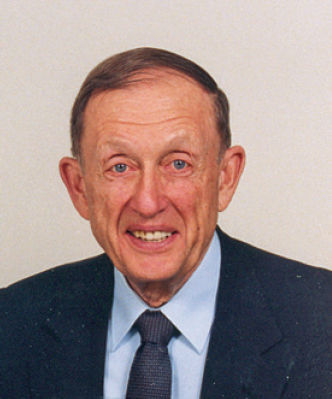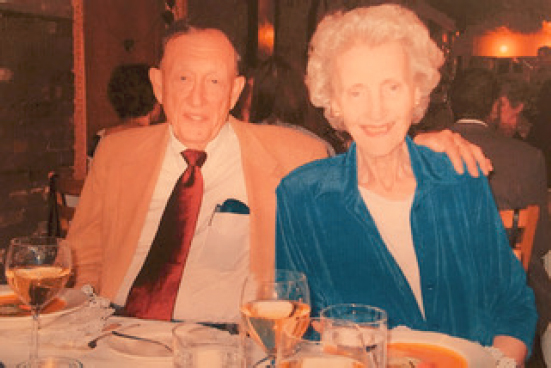

EDWIN N. LIGHTFOOT JR.
1925–2017
Elected in 1979
“Contributions to mass transfer and separation processes, and research on quantitative design procedures in biochemical and biomedical engineering.”
BY ABRAHAM M. LENHOFF, BERNARD O. PALSSON, AND STUART L. COOPER
EDWIN NIBLOCK LIGHTFOOT JR., Hilldale Professor Emeritus of Chemical Engineering at the University of Wisconsin–Madison, passed away October 2, 2017, at the age of 92.
He was born in Milwaukee September 25, 1925, to Edwin and Harriet Grimm Lightfoot, and grew up in nearby Wauwatosa. As a boy he loved chemistry and thought about becoming a chemist—until his father took him to Cutler Hammer to see where the chemists worked (the electroplating shop) and then where the engineers worked (desks and drawing boards). From that day forth, E.N. Lightfoot Jr. became an advocate for engineering education.
He received his BS degree in 1947 and his PhD degree in 1950, both in chemical engineering, from Cornell University. In 1949 he married Lila Smith of Newburgh, New York, which began a partnership that lasted 67 years.
Ed’s first job out of grad school was with the Charles Pfizer Co. in Brooklyn, NY, where he received a patent for the manufacture of vitamin B12. In 1953 he joined the University of Wisconsin–Madison Department of Chemical Engineering at the invitation of the chair, Olaf A. Hougen, who encouraged him to develop a biochemical research and education program in the department. Ed was promoted to associate professor in
1957 and full professor in 1961. During his career he supervised 49 doctoral students, many of whom are professors at leading universities and researchers in industrial biochemical and biomedical laboratories. He retired formally in 1996 but remained physically and intellectually active long beyond that time.
After World War II, as the field of chemical engineering matured and challenges became more complex, Lightfoot and colleagues R. Byron Bird and Warren Stewart recognized a growing need to provide students with unifying principles in a variety of transport phenomena. In the 1950s the trio developed an undergraduate course in the area, and in 1960 they published the groundbreaking textbook Transport Phenomena (John Wiley & Sons), which became widely known simply as “BSL” (the authors’ initials). The book beautifully unified the interrelated subjects of mass, heat, and momentum transfer and fundamentally changed how chemical engineering (and other engineering disciplines) were taught worldwide. The original text was in print 41 years and saw 5 translations; the second edition remains in print.
Separate from his renown as an author of BSL, Ed established a reputation as a brilliant researcher who, during his career of more than 50 years at Wisconsin, advanced the frontiers of an extraordinarily diverse range of highly interdisciplinary research topics. At the core was a pioneering research program in biochemical engineering, true to Hougen’s original guidance, that included collaborations with colleagues in disciplines ranging from medicine to environmental engineering.
Ed studied the dynamics of biological systems on length scales ranging from the physiological, where transport phenomena are pivotal, to the intracellular, where the complexities of metabolic networks dominate. His analyses of biomedical problems and contributions to the design of artificial organs, for example, contributed to his leadership in the emergence of biomedical engineering.
His interest in biochemical engineering also extended to bioprocessing, where his research on separation processes, especially membrane processes and liquid chromatography,
gained prominence. That the modern biotechnology industry was born near the midpoint of his career made his insightful opinions highly visible as this major industry sector took shape.
Ed’s research contributions beyond the biological sphere were also significant, including fundamental questions related to transport mechanisms. But his analytical approach was especially suited to dealing with the complexities of poorly defined systems, including many biological ones. Often starting from limiting order-of-magnitude calculations, he could pick apart largely impenetrable datasets to extract key organizing principles. These discoveries were fast-tracked into his teaching in such a way that different versions of his class on transport phenomena in living systems could cover substantially different topics. Preparing a lecture would include finding the data in the biomedical literature long before the days of online searching.
His painstaking efforts led to Ed’s authorship of Transport Phenomena and Living Systems: Biomedical Aspects of Momentum and Mass Transfer (Wiley, 1973), in addition to more than 225 papers and comprehensive book chapters. He continued to break new ground in his contributions to understanding biochemical and biomedical systems as he remained active in his research into his 90s, seeking insights especially into complex systems and issues. For instance, he studied parallels between biological processes and chemical industry systems and sought to develop an organizational framework for design, including by drawing parallels with evolution. He also published articles reporting observations of his own response to different medical therapies.
Ed earned a reputation for clearly conveying complex topics and instilling a love of learning—and of chemical engineering—in his students. He strongly felt that the purpose of education was to train the mind to be innovative, not to memorize facts—a philosophy he learned from his father, who held 55 utility patents plus a design patent and was known for disparaging “handbook engineers.”
Ed was always a teacher, whether in the halls of academe, enjoying the outdoors with his students, or at the dinner
table. His students knew him as energetic, kind, and particularly accessible as a mentor. He was also generous with his time at conferences and would go out of his way to compliment a young researcher whom he did not previously know on his/her presentation. He was proudly independent and iconoclastic, and thrived on debate; perhaps his most lasting impact on many students, not only those in his research group, was through his challenging and thoughtful questions often well beyond the typical technical issues that engineering students discuss.
Among his many honors, he was elected to the National Academy of Engineering in 1979 and the National Academy of Sciences in 1995. He received AIChE’s William H. Walker Award in 1975 and Warren K. Lewis Award in 1991 for contributions to chemical engineering literature and education, respectively. In 1992 he was recognized as a founding fellow of the American Institute of Medical and Biological Engineers, as well as a fellow of the American Academy of Arts and Sciences. In 2004 he was selected for the National Medal of Science “For his innovative research and leadership in transport phenomena focusing on biochemical and biomedical engineering with application to blood oxygenation, bioseparation techniques, and diabetic responses.” He received honorary doctorates from the University of Trondheim and the Danish Technical University.
Ed’s service to the profession was also noteworthy. He was on departmental and college advisory committees at the University of Utah, University of Houston, Purdue University, Montana State University, and Duke University. He also served on the National Research Council’s Committee on Separation Science and Technology (1983–87) and the NAE’s Membership Policy Committee (1993–96).
Ed enjoyed reading (in multiple languages), his dogs, the woods and especially his Sauk county farm, counting cranes, travel, cross-country skiing, sailing, canoeing, and bicycling. He traveled the world and lived in Norway (1962), on a Fulbright Fellowship, and New Zealand (1972), on an Erskine Fellowship; he also spent time in Denmark and Taiwan. He
had a deep concern for those in need and was always a cheerful, warm, and generous man.
Ed’s beloved wife, Lila, passed away in 2016. He believed that her influence was the key to not only his personal happiness but also his professional success. Together, they generously opened their home to many students and colleagues who became part of the extended Lightfoot family.
They are survived by their children Dory (Enrique Rueda), Edwin (Sue Dempsey), Nancy (Nick McGill), Robert (Karin Hunsicker), and David (Barry Burciul), and a granddaughter.






